We Greeks sit around the sea like frogs around a pond — Plato
There are a lot of mysteries surrounding my nonna’s family. Her name, for instance: was it DeAngelis or Iaccovazza? I’ve heard both. But until I get to the little town hall in her (fingers crossed) village near Salerno, I won’t have a chance of knowing for sure. So it’s still on the bucket list.
Tim and I had been to the region of Campania before. Tucked into the south-central west coast of Italy, it contains Naples, Sorrento, the Amalfi Coast, and Pompeii and, over the years, we have visited all those places. But lately, having discovered Basilicata to the east and the incredible Matera, I got interested in reading Carlo Levi’s 1945 classic, Christ Stopped at Eboli. Which, it so happens, is also in Campania.
Levi – doctor, painter, political prisoner because of his anti-Fascist views in 1935 — provides an account of his year-long exile in Lucania (now Basilicata) and the belief of the people that they have been abandoned by Christ, Christianity, and morality. They tell him they have been “excluded from the full human experience.” In other words, Christ stopped at Eboli, in Campania, and never made it any farther south, where the conditions were unspeakable and the people were mostly desperate.
So of course, I had to see Eboli. And Tim had to see Paestum, having heard that it was right up there with Pompeii. And so in May, without a tour to tend to, we took off from Sulmona and did a little exploration on our own.
Our base for three days was a hotel in the centro of Eboli which we reserved through AirBnB. It was magnificent. Apartamento “La Vacca”with its 16th century terrace off the kitchen, right next to an abandoned noble palazzo. There was evidence that someone had been working on the palazzo, but we saw no sign of it while we were there.
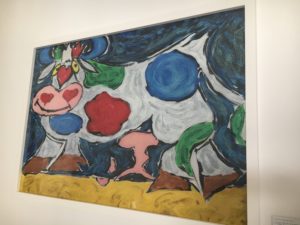
La Vacca was a fully furnished, contemporary, self-catering apartment of the highest quality with the best view in town. Of course, there was a vacca in the apartment – at least a painting of one – by one of the region’s prominent political artists, Francesco Cuomo. It’s a popular name in Eboli.
The modern, rather whimsical painting contained an assertion, which was anything but. It’s a wow. I’ll give you both versions:
L’italia é come una vacca
L’italia é come una vacca, nessuno ha il coraggio di accarezzala
— Ma tutti la vogliono mungere.
Italy is like a cow
Italy is like a cow, nobody has the courage to caress her
— But everybody wants to milk her.
The city smells like jasmine and boasts really fascinating architectural details. It’s a little reminiscent of Matera, actually, without the sassi. Very hilly, lots of ups and downs, but if you’re a good driver, you can manipulate the streets. And, unlike Matera, there are parking areas sprinkled throughout the centro.
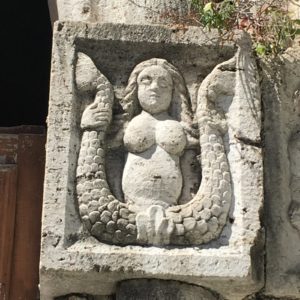
We found a few very nice restaurants in Eboli, especially the one on our last night. We ventured out late, not even sure we wanted to eat after a long day in Paestum, but stumbled upon a local place called Vico Rua, a pizzeria with an outdoor garden. Because it was late, we took the only table available inside and, even though the staff seems not to speak English, we managed brilliantly and had a fabulous send-off to Eboli. Good wines, good antipasti of local meat and cheese, and great pizza.
What really struck us (after the vacca painting in our apartment) is that this is clearly a city of artists – culinary, architectural, dance, music, and fine arts — who are very aware of the Carlo Levi connection. Vico Rua has a rotating art exhibit and, when we were there, there was a fantastic display of large wooden plates painted with a singular black-garbed character interacting rather joyfully with vegetables, bread, and cheese. Imaginative and smile-inducing. We walked back to the apartment full and happy that we had come.
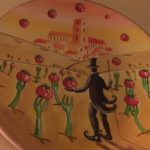
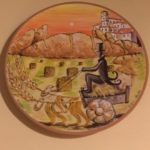
My first observation about Eboli, after checking in, was that this small city seemed to have its act together, tourist-wise. It is very frustrating in Abruzzo that the local businesses, together with the government tourist board are, for the most part, totally inept at marketing themselves. Upon arrival in Eboli, we were presented with brochures about a few museums, information about restaurants and accommodations, even a little bit about the history of the place. I was impressed.
But with the exception of the restaurant information, the brochures were mostly wrong. Nothing was open when they said it was. I was particularly disappointed about not getting to see the museum commemorating Operation Avalanche, the September 1943 Allied invasion of Italy through Salerno. We stood outside the museum’s doors for 20 minutes waiting for it to open, but it never did, and we were not alone. Score one for the tourist board, but it needs to get the attractions to play along.
Magna Graecia
Paestum, on the other hand, did not disappoint in any way. One of Italy’s UNESCO World Heritage Sites, the Parco Archeologico di Paestum is a must-see if you are interested in a classical tour of Italy, since it boasts the most extensive remains of Magna Graecia anywhere. An archaeological site housing three Greek temples and a variety of other ruins (Roman forum, amphitheatre, residential buildings), this is a fabulous place to spend a few hours.
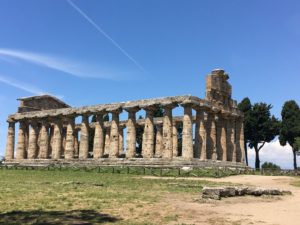
Because we were coming from Sulmona, about three hours away, we drove. But Paestum is actually serviced by train from Salerno to the north and Sapri to the south. We parked right near the train station and took the 15 minute walk down a shaded country road to reach the historical site, and were rudely announced by the white peacocks on the other side of a stone wall. If you’ve never heard a peacock call, Google it – it’s really odd.
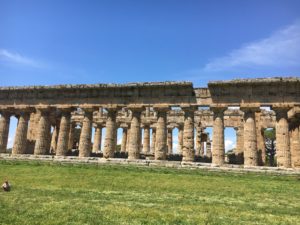
The original Greek city of Paestum, called Poseidonia, dates from around 600 BC. It was conquered by the Lucanians 200 years later and then by the Romans in 237 BC but, as the Roman Empire collapsed, so did Paestum. In the 18th century, the temples were rediscovered by local road builders, by intrepid travelers like Shelley and Goethe and, finally, by the emergence of the Grand Tour, which encouraged an interest in antiquities.
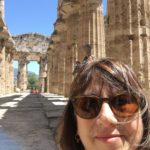
Even though the day was sunny and hot, we walked spellbound through the site with its three Doric temples: one to Athena, one to Hera, and the biggest one, to Neptune (Poseidon). They are without roofs now, but the remaining columns, pediments, and ornamentation speak to the remarkable skill of the builders and the gravitas of the buildings themselves.
We actually began our day at the Museum of Paestum across the street, and I would recommend that you do that, too, so you can get a good sense of what you will see (and also what you won’t see, in terms of preserved sculptures, wall paintings, and other artifacts). Take special note of the fresco of the “Tomb of the Diver,” from a Greek tomb; they seem to love that!
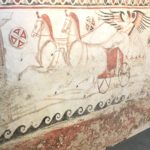
There were half a dozen groups of schoolchildren from the area at the museum the day we were there. Normally, I would find this a negative, but I was really pleased to see how interested they were in their local historical site and how much they were learning and interacting with their teachers and museum guides. It gave me hope for the study and significance of history, something which is being eroded here in Salem as I write this.
When it was time for lunch, we went out of our way to find a specific place that we had picked out that got good marks on Trip Advisor. We never did find it. But we did venture into a most unlikely spot – the Ristorante Museo, right next to the museum. Of course, we expected the worst – a tourist trap with bad food. We couldn’t have been more wrong.
Because we were eating late, we were one of only two groups of patrons in the place. We took an outside table and were served by a lovely waiter who we later learned was named Marco. We got to talking and soon the chef came out — wearing a NY Yankees baseball cap. With Tim’s Boston Red Sox hat, a friendly banter ensued.
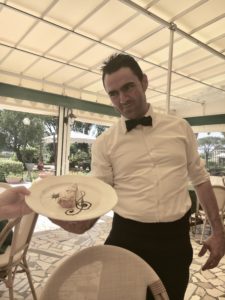
The chef, Franco, had worked for two years in London and 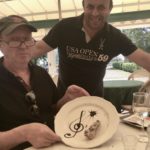 Folkestone and was a delight to talk to. A second waiter was also named Franco, and before long, the five of us were in a wonderful conversation about Italy, the Mezzogiorno, and food. There was no way that I could eat dessert after the meal, and even Tim, declined, but Marco brought him a small slice of a special cake that they made, with a decorated plate that was irresistible. When Tim wolfed the first slice down, he brought him a piece of another specialty!
Folkestone and was a delight to talk to. A second waiter was also named Franco, and before long, the five of us were in a wonderful conversation about Italy, the Mezzogiorno, and food. There was no way that I could eat dessert after the meal, and even Tim, declined, but Marco brought him a small slice of a special cake that they made, with a decorated plate that was irresistible. When Tim wolfed the first slice down, he brought him a piece of another specialty!
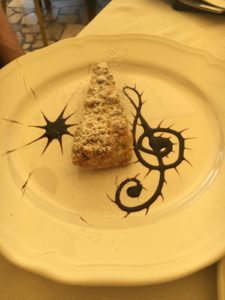 It was quite an afternoon, and a good farewell to Campania. As Tim and I walked back down the country road to get to our car, Marco pulled over in his car and asked if we wanted a ride (clearly we had been keeping them way beyond closing time), but we declined, saying that we needed a walk after the wonderful meal.
It was quite an afternoon, and a good farewell to Campania. As Tim and I walked back down the country road to get to our car, Marco pulled over in his car and asked if we wanted a ride (clearly we had been keeping them way beyond closing time), but we declined, saying that we needed a walk after the wonderful meal.
Campania has a lot of coastal charm that attracts thousands of visitors every year: Amalfi, Positano, Ravello, Naples, Sorrento . . . but it’s well worth going inland a bit to get a taste of ancient Greece — not to mention artichokes, tomatoes, figs, and lemons. And oh, what wine! Always, the wine — in this region, it’s the red Aglianico and the white Falanghina for me. We’ll be back to check out nonna’s village near Salerno. You should come, too!
Buon viaggio!
Linda Dini Jenkins is a card-carrying Italophile, travel planner, freelance writer, and amateur photographer. Travel is her passion, so writing about her travels just comes naturally. She hopes all her travelers find a way to express their joys, surprises, and fears as they travel and gives every traveler a nifty journal to help smooth the way. Learn more…
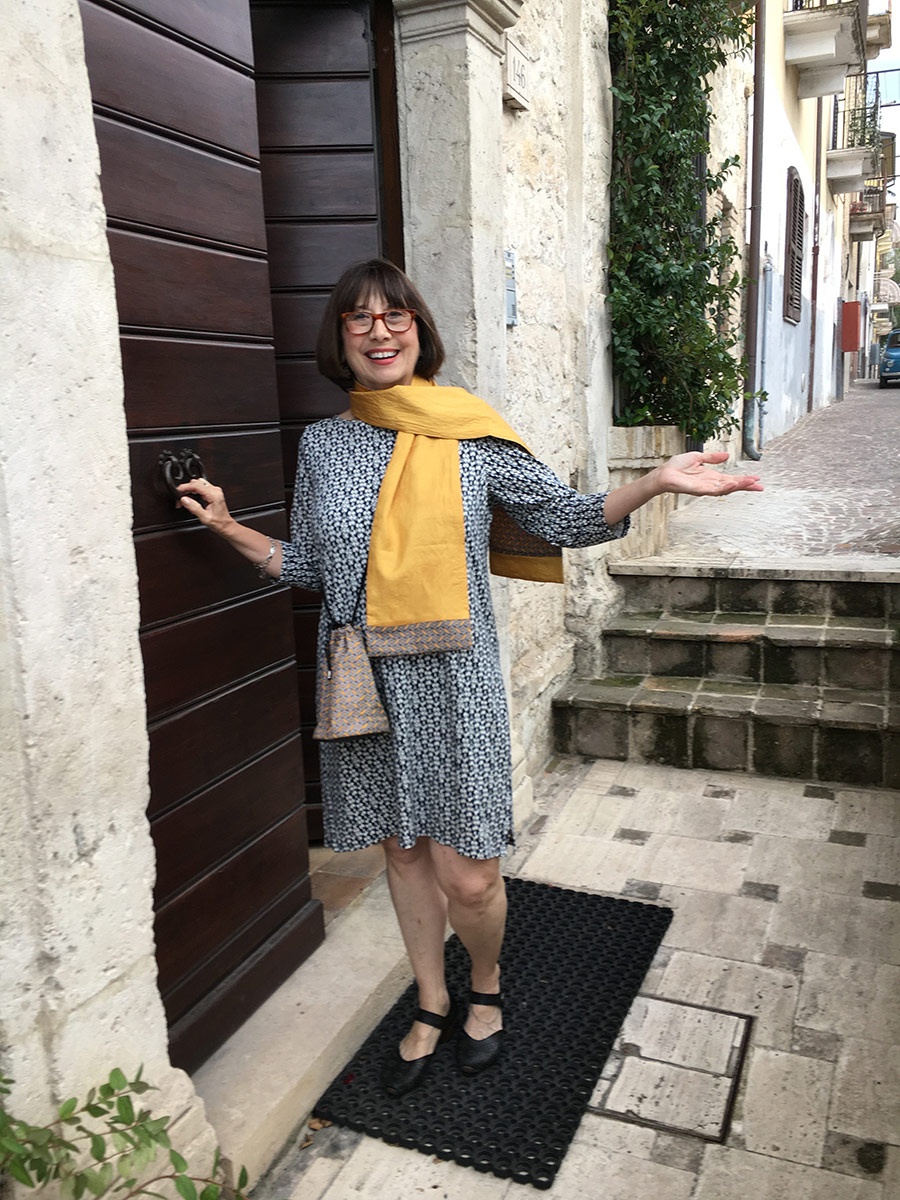
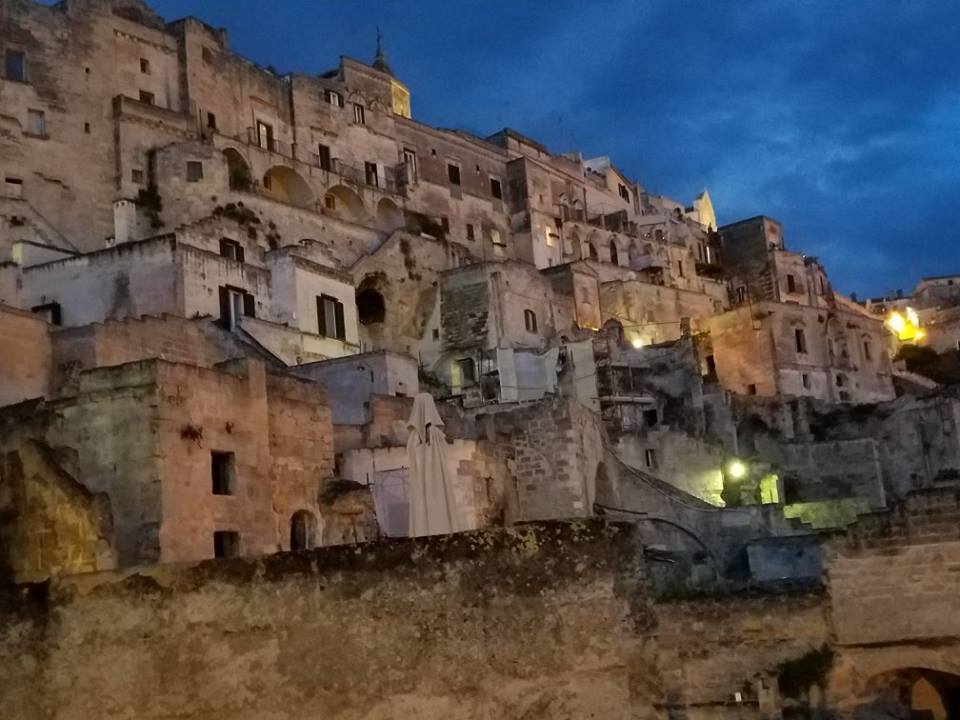
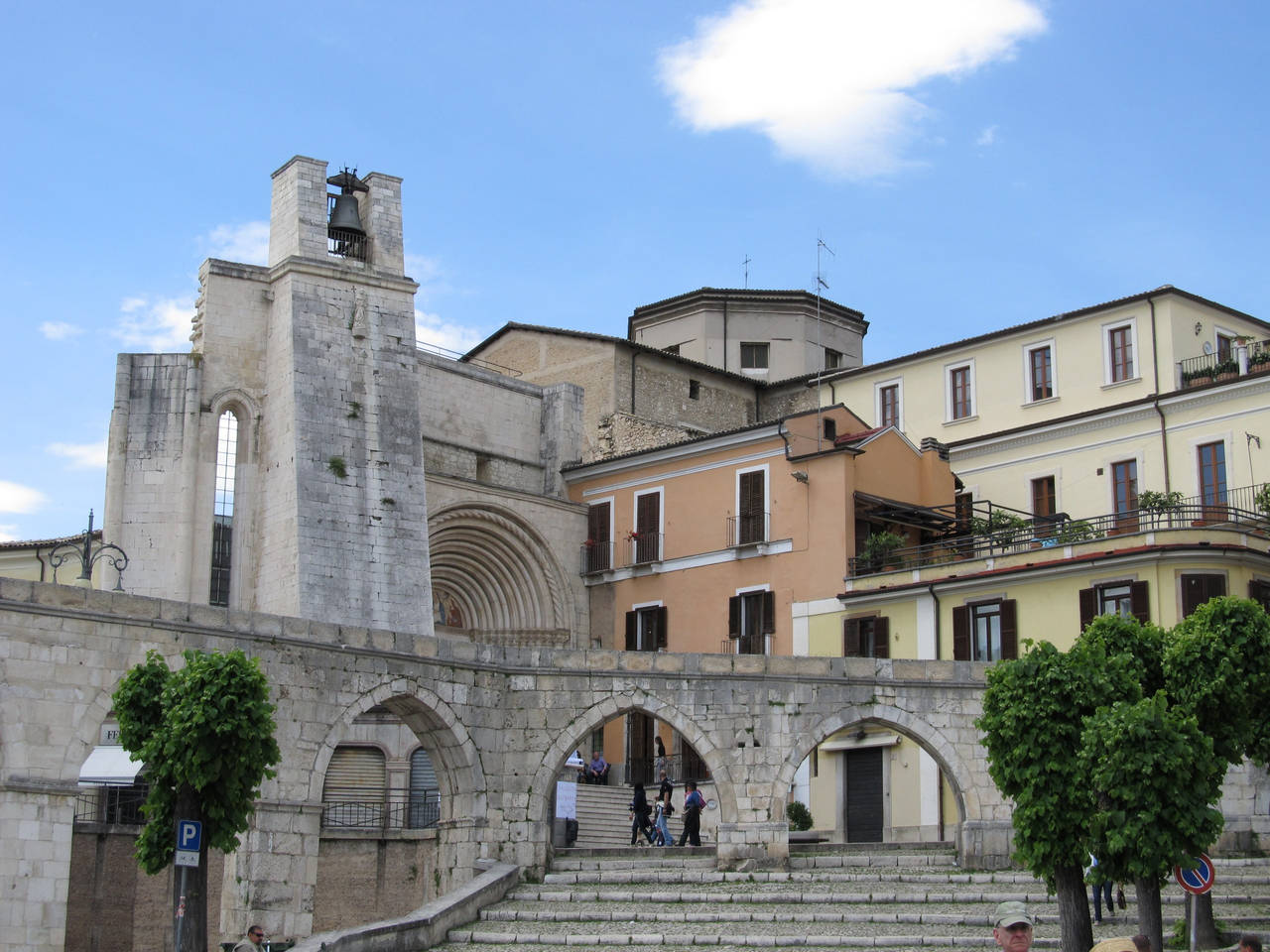

Recent Comments